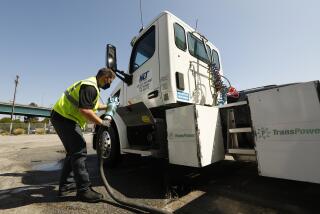Truckers are delivering better fuel efficiency
Diesel prices are at their highest level in nearly four years, topping $4 a gallon, but trucking company executive Fred Johring is taking it in stride.
Johring’s Golden State Express has bought low-emission, fuel-efficient diesel and natural gas rigs to comply with a clean-truck mandate at Southern California’s twin ports — with the fortunate side effect of easing the pain of high-priced diesel.
“We went from having one of the oldest local fleets to one of the newest,” said Johring, whose Rancho Dominguez company sends trucks mainly on short-haul trips to and from the ports of Los Angeles and Long Beach. “We have been somewhat insulated from the changing diesel prices.”
Since getting hammered by expensive diesel in 2008, Johring and many other transport specialists have altered their businesses to reduce diesel use. Coca-Cola Co. is using electric and hybrid vehicles and training drivers to reduce idling time. FedEx Corp. has adopted sophisticated software to improve truck loading and route planning with an eye toward fuel efficiency.
Even the look of the rigs has changed. To improve aerodynamics on the road, a cutting-edge cab these days sports deflectors on the roof and sides as well as extenders to close the gap with the trailer behind. The trailer might feature side skirts or angled trays underneath so that the air flows easily past and doesn’t drag on the vehicle, reducing the mileage a driver can get per gallon of fuel.
“Years ago, we preferred a classic style, rigs with tall front hoods,” said Corey England, executive vice president of his family’s trucking operation, C.R. England Global Transportation Inc., which operates as many as 320 rigs in California at any given time.
“Running those will lose you half a mile on every gallon,” England said. “It just doesn’t pencil out to do that.”
England recalled the day in 2008 when diesel prices had soared so high that the Utah company’s drivers started causing electronic service station pumps to crash as they filled up because the pumps weren’t designed to go above $999.99. This time around, the company was determined to be better prepared for high prices.
Every quarter, for instance, the most efficient of its 4,000 drivers wins a new Harley-Davidson motorcycle for accomplishments such as best mileage per gallon or lowest idling time. The company has turned some of its trucks into mobile test stations to assess potential technologies in the field.
“It has allowed us to hone the edge and put the best trucks and best drivers on the road,” England said.
Trucking companies and businesses with significant transportation costs were mostly caught unprepared in 2008, when diesel prices jumped more than 46% from January to July to a record national average of $4.76 a gallon. Then the global recession hit.
As hundreds of trucking companies folded, the industry shed nearly 178,000 jobs from January 2008 to December 2009, falling to a total of 1.2 million, according to the Bureau of Labor Statistics.
This time around, with the U.S. average diesel price at nearly $4.15 a gallon as of Monday, trucking industry employment has held steady at 1.3 million since the beginning of the year.
Part of the improved performance can be attributed to a stronger economy and fewer companies competing for business, industry officials say, but also to the extraordinary lengths that companies have gone to reduce their exposure to high fuel prices.
“For trucking companies, $4 diesel is a tipping point,” said Sean McNally, spokesman for the American Trucking Assn.
Since 2008, fleets have been overhauled to include the latest diesel trucks, which are more fuel efficient than older models, or have moved to electric or natural-gas rigs, according to a recent analysis by the London research firm Eyefortransport.
Trucking companies have turned to software programs to log speed and engine performance, improve routing and even shut down engines after a pre-determined amount of stationary time to reduce idling, the firm’s study found. Drivers are put through training programs that encourage efficient and conservative driving over other considerations.
Double-deck trailers allow more cargo without greatly increasing fuel use. Wide-profile tires offer less rolling resistance, and automatic systems ensure the proper tire inflation. Auxiliary power runs heaters and air conditioners during trucker rest breaks, the report said.
“It has paid off,” said Katharine O’Reilly, executive director of Eyefortransport, resulting in fuel savings of 3% to 10%. “They are in a much better position now in terms of financial viability.”
Atlanta-based Coca-Cola saved about 1 million gallons in 2011, or about 4.8% of annual fuel consumption, said Steven Saltzgiver, group director of Coca-Cola’s North American fleet. More fuel-efficient trucks, including electric and hybrid vehicles, have helped, as has Coca-Cola’s “smart driver” education program.
“Before we did this, our trucks were idling 30% of the time,” Saltzgiver said. “We first went down to idling 20% of the time. Now we are down below 10%, with an ultimate goal of getting down to 5%.”
FedEx is making greater use of “route operations support software” that helps the company save on fuel costs by loading trucks efficiently and mapping optimal delivery routes, spokesman Scott Fiedler said.
FedEx, which uses about 1.5 billion gallons of petroleum-based fuels a year, has improved fleet mileage 15% since 2005, Fiedler said.
“There’s no one solution,” Fiedler said. “We need to use the right vehicle and the right fuel on the right route.”







